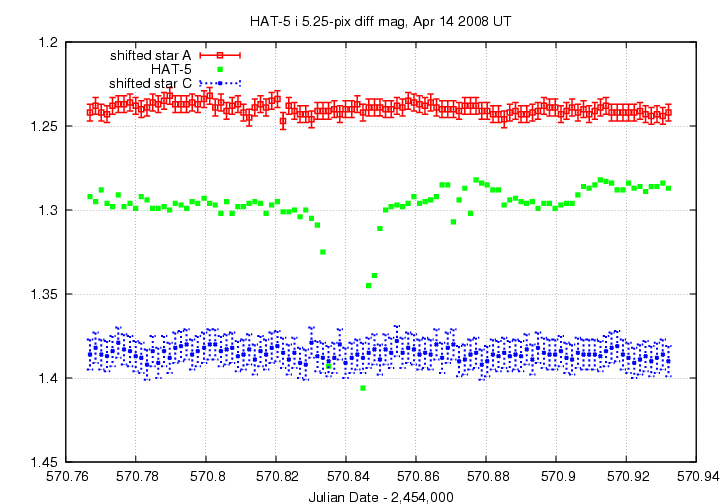
On the night of UT Apr 14, 2008, the SDSS Photometric Telescope ("PT" for short) took a series of exposures of HAT-5. The star fell near a bad column in the middle of the run, but we did detect the egress under good conditions.
Notes from the night
This is a chart of the field. HAT-5 is the bright star indicated by the crosshairs.

The host star of HAT-5 has a magnitude V=12 according to HAT-P-5b: A Jupiter-like Hot Jupiter Transiting a Bright Star.
Following the procedures outlined by Kent Honeycutt's article on inhomogeneous ensemble photometry, I used all stars available in each image to define a reference frame, and measured each star against this frame. You can find the software package used to do the ensemble photometry online; it's free!
The night was very clear. The graph below shows the amount by which instrumental magnitudes from each image needed to be shifted to match the ensemble reference. On a clear night, this graph would show a straight horizontal line.

Below is a graph of the scatter in differential magnitude versus magnitude in the ensemble solution.

HAT-5 is the star near differential mag 1.3; it shows a large excess in scatter due to the measurements made during its motion across the bad column. The "noise floor" in these measurements is about 0.003 mag -- very good.
Below are the light curves for the target (green symbols) and some comparison stars in the field. The big dip in the target star is due to a bad column.

In this closeup, I have shifted the data for two comparison stars to move them closer in magnitude to the target.

I don't see any ingress, but the level during the first half of the run is definitely lower than during the end of the run. There are two possible egress features: one at 570.88, which is followed by a brief, 0.02 dip, and then a second rise at 570.91. I don't understand why that second dip should appear.
Justin's notes indicate that the ephemeris prediction is for ingress at 570.762 -- just before the start of our measurements, which explains why we don't see it. The egress is predicted to occur at 570.884, which matches the first egress candidate feature I noticed.
You can grab the measurements for your own analysis. Below is a table with three flavors of time, plus the differential magnitude of the target and an estimate of the uncertainty in each measurement. I show the first few lines of the file to give you an idea of its format.
# Measurements of HAT-5 made with APO PT, Apr 14, 2008 UT. # Each exposure 55 seconds long in SDSS i-band; # Tabulated times are midexposure (FITS header time - half exposure length) # and accurate only to +/- 1 second (??). # 'mag' is a differential magnitude based on ensemble photometry # using a circular aperture of radius 5.25 arcseconds. # # UT day JD-2,450,000 HJD-2,450,000 mag uncert Apr14.76690 4570.76690 4570.76777 1.292 0.005 Apr14.76851 4570.76851 4570.76938 1.295 0.005 Apr14.77014 4570.77014 4570.77101 1.288 0.005
Last modified 07/03/2008 by MWR.